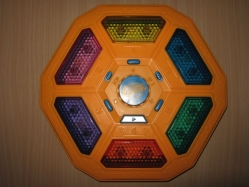
Autopsy:
from Wikipedia:
Simon is an electronic game of memory skill invented by Ralph H. Baer and Howard J. Morrison, with the software programming being done by Lenny Cope and manufactured and distributed by Milton Bradley.
Simon was launched in 1978 at Studio 54 in New York City and became an immediate success. It became a pop culture symbol of the 1980s.
source: wikipedia
Philips Videopac G7000 (1st generation) with Powersupply Inside used for Spare Parts because missing some pieces.
source: videopac faq
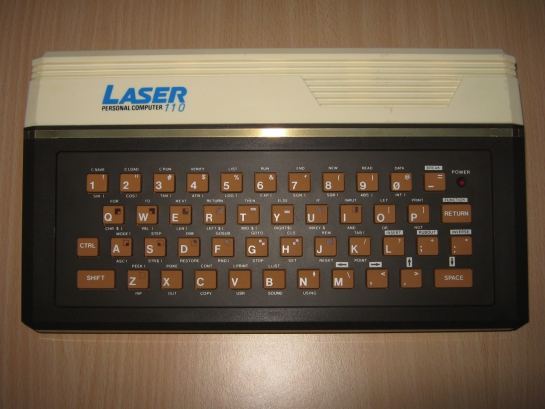
Autopsy:
from old-computers.com homepage:
The Laser 100/110 was the first model of the Laser 100/200/300 family. The ROM was nearly identical to the one of the Tandy Radio-Shack TRS-80 Color Computer, with only minor changes. It’s so close that when people write Laser emulators, they use TRS-80 CoCo ROM documentations (Laser detailed documentations are hard to find, especially about the ROM itslef).
The Basic was a Microsoft Basic just slightly modified to avoid lawsuits, some statements being stored in the ROM but not available on the machine! Like the most of the Vtech products, the Laser 100/110 was “cheaply” conceived: chicklet keyboard, plastic case, light-weight… It was produced to compete against the first wave of micro-computers like the famous Sinclair ZX-81.
The difference between the Laser 100 and the Laser 110 must be the RAM size (like the Laser 200 and 210), though very little information on the Laser 100 is available. The biggest difference with its big brother the Laser 200 was that it only had a black & white display. An obscure VZ-100 version was also released but this wasn’t the same machine as the VZ series sold in Australia and New-Zealand by Dick Smith Electronics.
source: old-computers.com
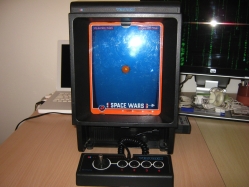
Autopsy:
from wikipedia:
The Vectrex is an 8-bit video game console that was developed by Western Technologies/Smith Engineering. It was licensed and distributed first by General Consumer Electric (GCE), and then by Milton Bradley Company after their purchase of GCE. It was released in November 1982 at a retail price of $199 ($430 compensated for inflation) as Milton Bradley took over international marketing the price dropped to $150 and then $100 shortly before the video game crash of 1983. The Vectrex exited the market in early 1984.
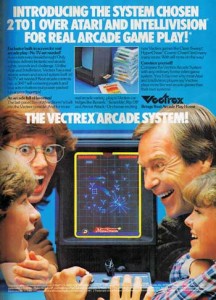 Unlike other non-portable video game consoles, which connected to televisions and rendered raster graphics, the Vectrex has an integrated vector monitor which displays vector graphics. The monochrome Vectrex uses plastic screen overlays to generate color and various static graphics and decorations. At the time, many of the most popular arcade games used vector displays, and GCE was looking to set themselves apart from the pack by selling high-quality versions of games such as Space Wars and Armor Attack.
Unlike other non-portable video game consoles, which connected to televisions and rendered raster graphics, the Vectrex has an integrated vector monitor which displays vector graphics. The monochrome Vectrex uses plastic screen overlays to generate color and various static graphics and decorations. At the time, many of the most popular arcade games used vector displays, and GCE was looking to set themselves apart from the pack by selling high-quality versions of games such as Space Wars and Armor Attack.
Vectrex comes with a built in game, the Asteroids-like Minestorm. Two peripherals were also available for the Vectrex, a light pen and a 3D imager. The Vectrex was also released in Japan under the name Bandai Vectrex Kousokusen. While it is a mainstay of disc-based console systems today, the Vectrex was part of the first generation of console systems to feature a boot screen, which also included the Atari 5200 and Colecovision.
source: wikipedia vectrex game database
Some fixes for the Electron Data Recorder ALF03.
- Fixed the output Audio.
- Replace the belt.
- Clean the tape head and fix the Azimuth.
- Fixed the Powersupply cable.
- Self made RGB Cable.
- Self made Data Recorder Cable (DIN 7 PINs).
Click here for my Acorn Electron computer.
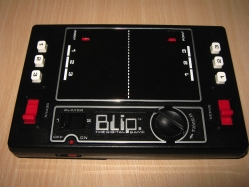
Autopsy:
This is a mechanical Pong-type game. All of the game play is mechanical, powered by a wind-up timer mechanism. The batteries are only there to light up the single red LED light that represents the ball.
You can actually play the game with no batteries in a bright enough setting.
source: pongmuseum.com
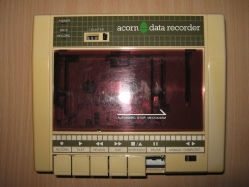
Autopsy:
Thanks to monkimann.
from wikipedia:
The Acorn Electron is a budget version of the BBC Micro educational/home computer made by Acorn Computers Ltd. It has 32 kilobytes of RAM, and its ROM includes BBC BASIC along with its operating system.
The Electron was able to save and load programs onto audio cassette via a supplied converter cable that connected it to any standard tape recorder that had the correct sockets. It was capable of basic graphics, and could display onto either a television set, a colour (RGB) monitor or a “green screen” monitor.
Click here for my Acorn Electron computer.
Click here for the Operating Instructions.
source: wikipedia
Thanks to monkimann.
Click here for my Acorn Electron computer.
Thanks to monkimann.
Click here for my Acorn Electron computer.
Working Sinclair ZX Spectrum 16k for Spare parts.
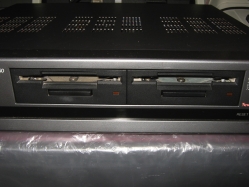
Autopsy:
Installation of a second Floppy Disk Drive for MSX 2 NMS-8250.
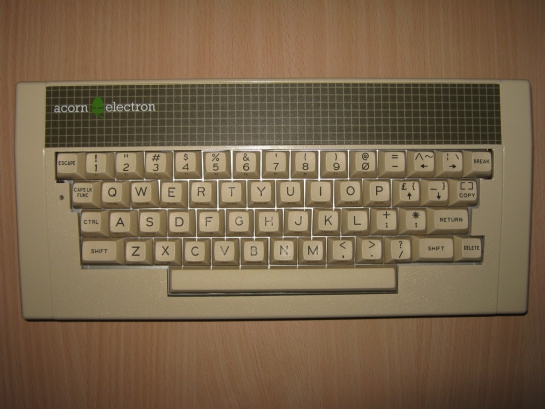
Autopsy:
from wikipedia:
The Acorn Electron is a budget version of the BBC Micro educational/home computer made by Acorn Computers Ltd. It has 32 kilobytes of RAM, and its ROM includes BBC BASIC along with its operating system.
The Electron was able to save and load programs onto audio cassette via a supplied converter cable that connected it to any standard tape recorder that had the correct sockets. It was capable of basic graphics, and could display onto either a television set, a colour (RGB) monitor or a “green screen” monitor.
At its peak, the Electron was the third best selling micro in the United Kingdom, and total lifetime game sales for the Electron exceeded those of the BBC Micro. There are at least 500 known games for the Electron and the true total is probably in the thousands[citation needed]. The hardware of the BBC Micro was emulated by a single customized ULA chip designed by Acorn.
It had feature limitations such as being unable to output more than one channel of sound where the BBC was capable of three-way polyphony (plus one noise channel) and the inability to provide teletext mode.
The ULA controlled memory access and was able to provide 32K × 8 bits of addressable RAM using 4 × 64K × 1-bit RAM chips (4164). Due to needing two accesses to each chip instead of one, and the complications of the video hardware also needing access, reading or writing RAM was much slower than on the BBC Micro.
This meant that although ROM applications ran at the same speed, there was a substantial speed decrease on applications running from RAM.
source: wikipedia
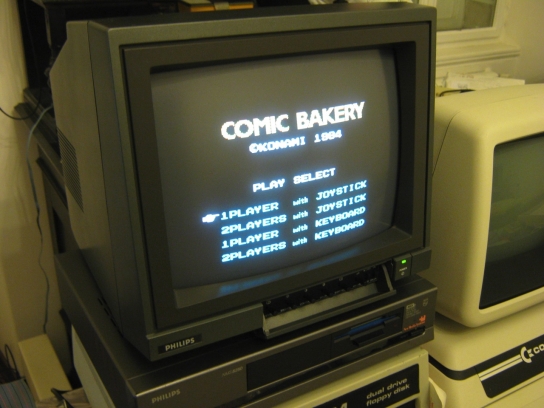
Autopsy:
I fixed two problems of this monitor: the PowerSwitch and the Video Composite input.
The monitor is a VS0080 RGB Color Monitor, which is technically identical to the Commodore 1084 Monitor, but with a black case to match the MSX colors
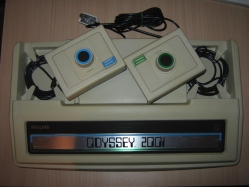
Autopsy:
from pong-story homepage:
Magnavox started to export video games in 1974. At first, Odyssey was exported in 1974 in more than ten countries. Later in 1976, Philips released the Philips Odyssey 200 in several countries including Austria and Germany. Finally, the Philips Odyssey 2001 and the Odyssey 2100 were released in 1977 and 1978.
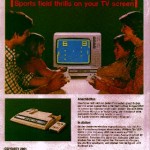 The Odyssey 2001 is nearly same as the Magnavox Odyssey 4000, but it didn’t play the same games. Designed around the National Semiconductor MM-57105 chip, it played three games in color: Tennis, Hockey and Squash. Unlike most PONG games, sound came directly from the TV set. The chip delivered color video signals, as opposed to the black and white games of the General Instruments game chips, which could use a special color encoder chip.
The Odyssey 2001 is nearly same as the Magnavox Odyssey 4000, but it didn’t play the same games. Designed around the National Semiconductor MM-57105 chip, it played three games in color: Tennis, Hockey and Squash. Unlike most PONG games, sound came directly from the TV set. The chip delivered color video signals, as opposed to the black and white games of the General Instruments game chips, which could use a special color encoder chip.
The game selection was simply done by pressing the button of one of the two controllers, allowing the players to switch from a game to another. The documentation of this console exists in ten languages, although only four foreign patents are shown on the back side of the system. The exact number of countries where this system sold is still unknown. This system is quite common, and Germany seems to be the country where it was most successfull.
source: pong-story.com wikipedia
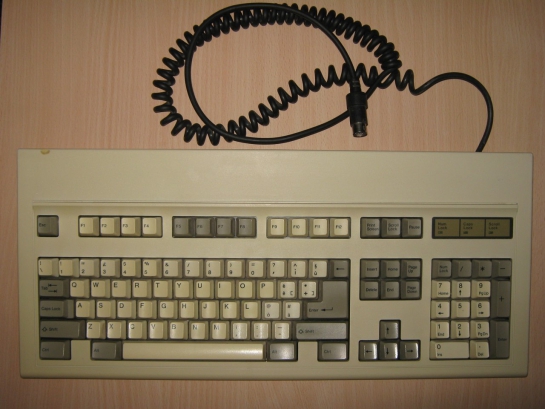
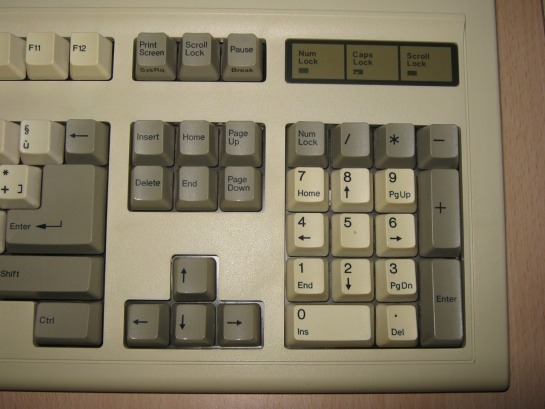
This is a IBM PC Compatible Microswitch Keyboard from 80 years with AT/XT switch.
















































 Unlike other non-portable video game consoles, which connected to televisions and rendered raster graphics, the Vectrex has an integrated vector monitor which displays vector graphics. The monochrome Vectrex uses plastic screen overlays to generate color and various static graphics and decorations. At the time, many of the most popular arcade games used vector displays, and GCE was looking to set themselves apart from the pack by selling high-quality versions of games such as Space Wars and Armor Attack.
Unlike other non-portable video game consoles, which connected to televisions and rendered raster graphics, the Vectrex has an integrated vector monitor which displays vector graphics. The monochrome Vectrex uses plastic screen overlays to generate color and various static graphics and decorations. At the time, many of the most popular arcade games used vector displays, and GCE was looking to set themselves apart from the pack by selling high-quality versions of games such as Space Wars and Armor Attack.












































































































 The Odyssey 2001 is nearly same as the Magnavox Odyssey 4000, but it didn’t play the same games. Designed around the National Semiconductor MM-57105 chip, it played three games in color: Tennis, Hockey and Squash. Unlike most PONG games, sound came directly from the TV set. The chip delivered color video signals, as opposed to the black and white games of the General Instruments game chips, which could use a special color encoder chip.
The Odyssey 2001 is nearly same as the Magnavox Odyssey 4000, but it didn’t play the same games. Designed around the National Semiconductor MM-57105 chip, it played three games in color: Tennis, Hockey and Squash. Unlike most PONG games, sound came directly from the TV set. The chip delivered color video signals, as opposed to the black and white games of the General Instruments game chips, which could use a special color encoder chip.




Recent Comments